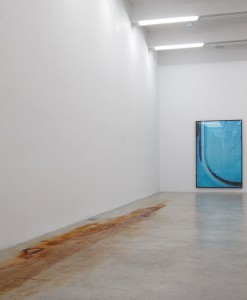

It makes sense that I would discover the work of Daniel Turner and Colin Snapp while haphazardly clicking through VVORK. Their ongoing collaboration, Jules Marquis, encapsulates the omnivorous taste of that lo-fi curatorial forum. Working with and through sculpture, film, performance, installation, appropriation, and many other media, Jules Marquis has created a body of work that is a balance of opposites; political and disengaged, holistic and site-specific, linear and circular. Their piece Delta performance JFK to LGA is a case in point. A flight between JFK and LGA, at a cost of about $500, the work can be read as sharp critique of consumerist waste. Or perhaps it is a simple gesture that recalls the almost universal cultural experience of an airplane’s non-space. Or it is simply a journey that ends nowhere.
While Colin and Daniel also have two very distinct solo practices, and exhibit often on their own, their new show at Martos Gallery in Chelsea marks the first time they will show their solo work together. I recently sat down with the two of them in their Greenpoint studio to watch some videos and discuss their work.
You have collaborated together under the names Cornrow Rider and Jules Marquis for over ten years. What made you decide to exhibit your solo work together?
It was about timing, our entire practice is about timing.
Colin, your films often document what might be called found, everyday performance; in Maybelline, you focus in on the repeated gestures of rock climbers, and in Sylvania on the prostrations of two men who seem to worshiping the ocean. Do you set out to films these occurences? What is your interest in them, as opposed to literal, fictional, or reenacted performance?
The line between documentary and performance is at the core of my work. Each video has its own story. In the case of Maybelline I did travel to Joshua Tree to film rock climbers, beyond that nothing was planned. Sylvania, on the other hand, was completely spontaneous. The improvisational aspects of video is something that has always interested me. I walk a lot, often up to 30 miles a day. Many of these video works are my attempt to make use of these travels.
Colin, one of the most interesting aspects of your video work is the interplay between sound and image. Some pieces feature diegetic sound – in Maybelline, the sound of carabiner against rock, for instance. In other films, however, you create incongruous, and uncannily apt, pairings – soothing images of waves with sitar music, or a tightly focused image of a carnival ride accompanied by classical music. Can you talk about what you feel this different aesthetic strategies offer?
For the mentioned works I made those decisions in post production. Whatever worked with the footage best I went with, whether that was found music or a field recording. Recently I have been focusing more on the audio aspects of my practice. I’m working on a new series in which I use the field recordings as a jumping off point for the videos.
Daniel, you work seems to explore an ephemeral materiality, using very basic, almost elemental substances – soot, aluminum, tar, rust – that leave fleeting marks on the surface they stain, and whose character changes over time. Your work in this show consists of iron oxide (rust) on the floor of the gallery. Could you talk about your interest in temporarility and material, in these marks of change or decay?
I’ve always had a infinity for times mark upon a given surface. I started out painting, using materials such as liquid aluminum, tar, and kerosene, on large canvas tarps. After time the tarps begin to sag, the stretcher bars begin to buckle, the paintings leaked. Operating pictorially began to make little sense to me, yet the actual material I was painting with was of interest. On the steel wool rubbings: The general conversation around steel, is one of its history and weight. Yet the steel rubbings are virtually weightless, and its this dialogue that I am interested in. Present yet simultaneously absent.
The work of Jules Marquis is very different than either of your solo practices. It draws on the legacies of appropriation art, as with Rwanda, or on post-studio performance, in the case of Delta performance JFK to LGA. What do you feel collaborative practice allows you to explore that solo practice can’t, and vice versa?
Collaboration allows for one to venture into other arenas that go generally untapped. It gives you a tremendous amount of perspective on your own practice while allowing to explore another. One becomes almost bilingual through the integration of once separate mediums.
Colin Snapp / Daniel Turner
June 30th – July 29th, 2011
Martos Gallery
540 W 29th Street
New York, NY 10001


One Trackback/Pingback
[...] June, we talked to artists Colin Snapp and Daniel Turner about how their solo practices have evolved out of their [...]